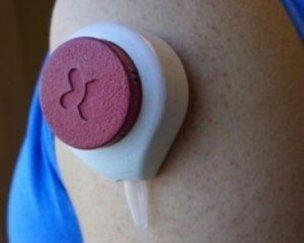For those of us who have an irrational fear of sitting in a chair and watching your very lifeblood seep out of our body via a painful needle and tube, a less confronting approach to blood extraction is definitely welcome news.
Developed by Tasso Inc., a US-based company run by graduates of the University of Wisconsin-Madison, the blood test is a ping-pong ball-sized device that you hold against your skin for two minutes, and blood is sucked out via a "slight vacuum" into an attached tube. The sample is then able to be mailed off or hand-delivered to the lab or GP.
"The technology relies on the forces that govern the flow of tiny fluid stream," vice president and co-founder of Tasso Inc, Ben Casavant, said in a press release. "At these scales, surface tension dominates over gravity, and that keeps the blood in the channel no matter how you hold the device."
Maddie Stone explains the technology over at Gizmodo:
"Rather than puncturing a vein, when the user holds this device against his or her skin, it creates a slight vacuum that immediately starts to pull blood from many microscopic open channels called capillaries.
During the process, capillary action - the same physics that causes water to wick up paper - beckons blood into an attached collection container. The device can currently extract about 0.15 cubic centimetres of blood, enough for most routine lab analyses, including cholesterol, infection, cancer cells and blood sugar tests."
According to Stephanie Castillo at Medical Daily, those who have tried the test say it's almost entirely painless. The company has been given a $3 million grant by the US Defenses Advanced Research Projects Agency (DARPA) to help get it to the market, which they predict should be by some time in 2016, if they get approval from the US Food and Drug Administration later this year. The aim of the DARPA funding is to figure out how to keep the blood at an optimal temperature for the trip to the lab, which can be a bit tricky when you can't exactly put it on ice in the post.
In the meantime, hopefully we'll hear a little more about exactly how the device works. If the team can get it to the market, it could be pretty revolutionary.
"We see our specialty as people who need to test semi-frequently, or infrequently, to monitor cancer or chronic infectious diseases," said Casavant. "Instead of buying a machine or expensive equipment, we ship you this device, you put it on your arm for two minutes and send it back to the lab."
Source: Gizmodo, Medical Daily
